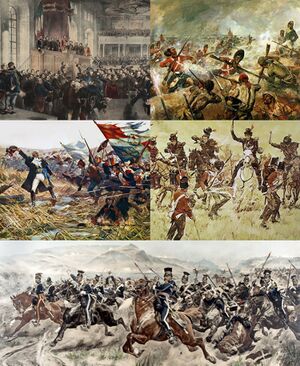Ambrosian Revolution: Difference between revisions
No edit summary |
No edit summary |
||
| Line 10: | Line 10: | ||
| combatant1 = [[File:Russia Naval 1720 forked 2.svg|22px]] [[Ambrose|Provisional Confederation]]<br>{{flagicon|Ambrose}} [[Ambrose|Confederal Republic]] | | combatant1 = [[File:Russia Naval 1720 forked 2.svg|22px]] [[Ambrose|Provisional Confederation]]<br>{{flagicon|Ambrose}} [[Ambrose|Confederal Republic]] | ||
| combatant2 = [[File:Royal-Flag-of-Ambrose.png|22px|border]] [[Kingdom of Ambrosia]] | | combatant2 = [[File:Royal-Flag-of-Ambrose.png|22px|border]] [[Kingdom of Ambrosia]] | ||
| commander1 = [[File:Russia Naval 1720 forked 2.svg|22px]] '''[[Nathaniel Gorham]]'''<br>[[File:Russia Naval 1720 forked 2.svg|22px]] [[Alexander Porter]]<br>[[File:Russia Naval 1720 forked 2.svg|22px]] [[Henry John Pinckney]]<br>{{nowrap|[[File:Russia Naval 1720 forked 2.svg|22px]] [[Cadwyn Gates Price]] {{KIA}}}} | | commander1 = [[File:Russia Naval 1720 forked 2.svg|22px]] '''[[President of Ambrose#List of Presidents|Nathaniel Gorham]]'''<br>[[File:Russia Naval 1720 forked 2.svg|22px]] [[Alexander Porter]]<br>[[File:Russia Naval 1720 forked 2.svg|22px]] [[President of Ambrose#List of Presidents|Henry John Pinckney]]<br>{{nowrap|[[File:Russia Naval 1720 forked 2.svg|22px]] [[Cadwyn Gates Price]] {{KIA}}}} | ||
| commander2 ={{flagicon image|Royal-Flag-of-Ambrose.png}} '''[[Edgard IX]]''' {{Executed}}<br>{{flagicon image|Royal-Flag-of-Ambrose.png}} [[William Barker, Thane of Fife|Thane of Fife]]<br>{{nowrap|{{flagicon image|Royal-Flag-of-Ambrose.png}} [[George Audely, Duke of Shrewsbury|Duke of Shrewsbury]] {{Executed}}}}<br>{{flagicon image|Royal-Flag-of-Ambrose.png}} [[Archibald Casterman, 5th Baron Somerset|Lord of Somerset]] | | commander2 ={{flagicon image|Royal-Flag-of-Ambrose.png}} '''[[List of Ambrosian monarchs|Edgard IX]]''' {{Executed}}<br>{{flagicon image|Royal-Flag-of-Ambrose.png}} [[William Barker, Thane of Fife|Thane of Fife]]<br>{{nowrap|{{flagicon image|Royal-Flag-of-Ambrose.png}} [[George Audely, Duke of Shrewsbury|Duke of Shrewsbury]] {{Executed}}}}<br>{{flagicon image|Royal-Flag-of-Ambrose.png}} [[Archibald Casterman, 5th Baron Somerset|Lord of Somerset]] | ||
| strength1 = 178,900 | | strength1 = 178,900 | ||
| strength2 = 143,500 | | strength2 = 143,500 | ||
Latest revision as of 22:14, 5 May 2019
| Ambrosian Revolution | |||||||
|---|---|---|---|---|---|---|---|
 Clockwise from top left: The Proclamation of the Republic; the Battle of the St. John Heights; the Battle of Ipswich; Charge of the Highland Dragoons; Price's Charge at Adwalton | |||||||
| |||||||
| Belligerents | |||||||
|
|
| ||||||
| Commanders and leaders | |||||||
|
|
| ||||||
| Strength | |||||||
| 178,900 | 143,500 | ||||||
| Casualties and losses | |||||||
| 76,800 | 81,9000 | ||||||
The Ambrosian Revolution, also known as the First Ambrosian Civil War, was a civil war fought in Ambrose from 1848 to 1849. The war was rooted in the spread of liberal enlightenment ideals among the landed gentry, as well as national disasters such as economic downturn, the wheat famines, and the disastrous defeat in the Third Ambro-Sjealandic War; the last of which caused much of the Royal Army to lose faith in the monarchy. After two years of bloody combat the monarchist government collapsed, leading to the formation of the Ambrosian Confederal Republic.
After failing to take direct command of Elsbridge's army garrison, King Edgard IX fled to his court in Tidsmouth, allowing for the army to take control of the capital and declare martial law. Liberal intellectuals, having secured the support of select elements of the army, declared a republic. Edgard attempted to consolidate his armies (which had been dispersed in fear of foreign invasion) near Wellsworth in an attempt to retake the capital, however this was hampered by the defection of large parts of the army, disillusioned with the monarchy, to the revolutionaries. In addition to this, the remaining royalist armies were harried by bands of bushwhackers; this meant that the Combined Royal Army formed by autumn was in no state to launch any major offensive. By this time, most of Ambrose's port cities had either been captured by the steadily-growing Republican armies or fallen to peasant mobs; this denied a crucial stream of supplies to the royalists, who became increasingly encircled in the country's interior.
Despite having retreated to the strongly-fortified banks of the River Tid, the brutal winter of 1848/49 further depleted the royalist numbers, and Edgard was forced to abandon his position in March. Running desperately short of food and ammunition, an attempt at resupply near the Northumbrian border was complicated by partisan resistance, allowing the Republican provisional government in Elsbridge to dispatch an army under Nathaniel Gorham to meet them. The ensuing Battle of Adwalton Pass saw the annihilation of the Combined Army and the capture of King Edgard, who would be summarily executed. The remaining royalist armies continued to resist throughout the spring and early summer, claiming Edgard's 12 year-old son as their King. However a general amnesty announced by the Republicans caused the surrender of the isolated royalist forces across the country.